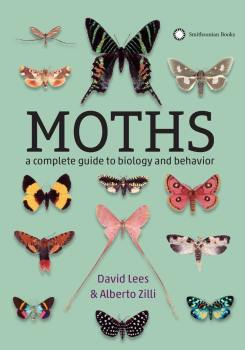Why Are Moths Are Attracted To Light?
Surprisingly, there isn’t only one theory.
The following is an excerpt of Moths: A Complete Guide To Biology And Behavior by David Lees and Alberto Zilli.

Moths: A Complete Guide To Biology And Behavior
The potentially fatal lure of the moth to the flame has long been a scientific mystery. Most nocturnally active moths are attracted to light, a phenomenon known as positive phototaxis. However, some species like the Old Lady (Mormo maura) tend to be repelled by it (they are negatively phototactic). With the invention of ultraviolet (UV) lamps for medical purposes just before the WWII, it was discovered that sources rich in UV greatly increased moth attraction to light. Insects, and especially moths, are particularly sensitive to the UV part of the electromagnetic spectrum. There have been a number of theories that try to explain this.
A common theory is that moths are attracted to the moon, and therefore they should fly higher on moonlit nights. A better theory is that moths can use the moon or stars to orientate, and that a moth adjusts its flying track to keep the light source at a constant angle to the eye. However, whilst rays from a celestial source would all be seen as parallel, those from a lamp radiate all around.
Accordingly, a moth on the wing would constantly turn inwards to keep itself at a constant angle to the light, ending up in a spiralling path which would make it eventually collide with the lamp. However, moths rarely exhibit such geometric trajectories, but rather take circuitous routes when coming to light, making loops and coils perhaps due to a compromise with escape responses or disturbance by wind plumes. Moths are also affected by a general phenomenon known as dorsal light reaction. Most flying animals, in fact, tend to keep the lighter sky above them (they do not fly upside down!), and will therefore also dip down when closing in on an artificial source that they then confuse with the sky light. Moth traps are designed to exploit the inwards spiralling responses of moths, using suitably placed barriers (baffles) around the lamp that they can collide with, so that they will then fall down through a collecting funnel into the trap.
In the 1970s, Philip Callaghan developed the infrared theory of light attraction. His view was that UV light pumped moth female pheromone molecules in the air into an excited state, so they emitted photons of infrared microwave radiation that could potentially be detected by sensilla on the male antennae, that he postulated were the right size to function as waveguides. The theory has not, however, gained much traction, because although males are more frequently attracted to light, it is known that pores on the moth sensilla are just the right size to detect pheromone molecules directly. Males are the more mobile sex anyway, and this hypothesis does not satisfactorily explain the attraction of females to light.
It is still not fully known how far you can attract moths from using an artificial light source. A classic experiment in 1978 by Robin Baker and colleagues at Manchester University suggested that most moths are attracted to light traps on the ground when they are only in the range of the light by just a few meters. Other trials in Germany in a region away from light pollution though, have shown that street lamps can attract moths only up to about 30–80 feet away. In the last two cases, the light is only attracting the positively phototactic moths that happen to wander into the light source’s small sphere of influence during the night.
Light attraction works better on dark nights or in places where there is no competition with other
light sources, including notably the moon, and so a longer distance response should also work. The moth’s behavior of keeping a constant angle between its flight trajectory and the light rays emitted by an artificial source would then enable a moth to arrive at a single brightest light source perceived from a matter of kilometers as if it were a star.
Tropical biologist Daniel H. Janzen in a 1984 classic paper on big moths in Costa Rica noticed that many hawkmoths (Sphingidae) were feeding on flowers nearby a light source and yet not being attracted to it. Janzen asserted that sphingids behave differently through their adult life and spend some time building up a model of their home range early after emergence. At this time they rely on celestial cues and are more prone to be attracted at light. Once familiarized with their habitat, he proposed they could switch off their initial positively phototactic response and turn to orienting using landscape features. This switching mechanism needs detailed testing, but Janzen asserted that mainly fresh hawkmoths were found at light whereas those feeding on nearby flowers were often worn, hence older.
Not all moths will be attracted to light, and the reasons for positive and negative phototaxis are not clear. The latter has, however, a clear meaning for cave-sheltering species like the Tissue Moth (Triphosa dubitata), which actively flies towards deep dark patches among rocks.
Adapted from Lees, D.C. and Zilli, A. 2019. Moths: A Complete Guide To Biology And Behavior. (ISBN 978 0 565 09457 7). Copyright © 2019 by The Trustees of the Natural History Museum, London, 2019 and published by the Natural History Museum, Cromwell Road, London, SW7 5BD. All rights reserved.
David Lees is a doctor of science and a curator of Lepidoptera at the Natural History Museum in London, United Kingdom.
Alberto Zilli is is Curator of Lepidoptera at the Natural History Museum, London.